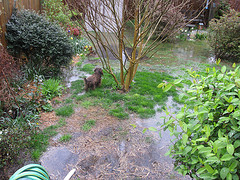 One benefit many people tend to forget when considering artificial grass is its ability to control pests. More often than not, people tend to think solely of the minimal amount of maintenance artificial or synthetic grass needs. The overall cost of caring for a lawn made of synthetic materials is also drastically lower than that of natural grass (learn more about the cost of natural grass). The cost effective and time saving benefits tend to overshadow pest control.
One benefit many people tend to forget when considering artificial grass is its ability to control pests. More often than not, people tend to think solely of the minimal amount of maintenance artificial or synthetic grass needs. The overall cost of caring for a lawn made of synthetic materials is also drastically lower than that of natural grass (learn more about the cost of natural grass). The cost effective and time saving benefits tend to overshadow pest control.
No Standing Water
When an area is prepared for the installation of artificial turf, the ground is leveled as much as possible to remove any dips and valleys. Once everything has been smoothed over, a fine layer of pea gravel or rubber chips are spread evenly to fill in and cover the soil. Trenches are then created that allows the water to drain away from the property and either enter the storm drain or be carried away via a drainage system of some sort. This unique system of channels and trenches eliminates any standing water and prevents mosquitoes and other insects who nest in water to create a viable breeding ground.
Reduces Feeding Resources
For insects, spiders, birds and bugs that need the soil to thrive, artificial turf poses a problem. There are several reasons insects cannot thrive on or near synthetic grass:
-
Limited access to the soil
-
Bacteria resistant
-
No “green” or plant based food
-
No flowers or flowering grasses
With limited food sources, insects cannot stay in the area long enough to breed or cause extensive damage to other plants or shrubbery. Since insects cannot nest or reproduce in the area, there is no need for expensive insecticides that can harm pets and children.
Artificial turf is not affected by extreme temperatures or weather conditions. One thing that is also beneficial when it comes to pest control, is the fact that synthetic grass holds and reflects heat. Many insects can tolerate high temperatures but not for prolonged periods. Because artificial grass holds heat, it will remain warm long into the night, even after the sun goes down, making it unacceptable for many insects.
Limited Access to Soil
Many insects require access to soil. Because of the layers of gravel or rubber and the turf covering, bugs and insects cannot reach down into the dirt and get to the food resources located there. A few insects also use the soil to lay their eggs or larvae, with no access to the actual dirt, they cannot thrive in an area where there is no soil. They may be able to live for awhile around the edges of an artificial grass lawn, but even then it may become too much for them and they will be forced to migrate elsewhere.
Insects and small animals, such as rabbits, can attack and destroy certain types of grasses and plants. By feeding on the tender shoots or the roots as they emerge from the ground, they can cause large area of a lawn to thin out and eventually become barren. Artificial turf remains green throughout the year and will not discolor, wear away due to large amounts of foot track or fade under heavy shade.
By installing artificial grass, you not only reduce the amount of time you spend working in the yard, you also limit the amount of money that is needed to effectively maintain the area. You can also effectively control the number of pests that enter and damage your lawn each year. Even if you only install synthetic grass in a portion of your lawn, the savings will be quite dramatic. You can have a beautiful, pest free lawn, with little if any, additional cost.
Photo Credit: Tony Alter via flickr









